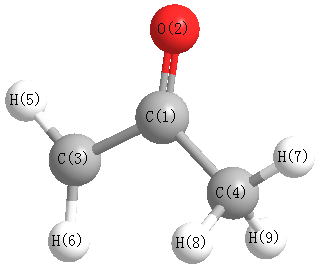Vibrational Frequencies calculated at TPSSh/cc-pVDZ
| Mode Number |
Symmetry |
Frequency
(cm-1) |
Scaled Frequency
(cm-1) |
IR Intensities
(km mol-1) |
Raman Act
(Å4/u) |
Dep P |
Dep U |
|---|
| 1 |
A' |
3260 |
3170 |
4.95 |
|
|
|
| 2 |
A' |
3156 |
3069 |
8.35 |
|
|
|
| 3 |
A' |
3135 |
3048 |
4.64 |
|
|
|
| 4 |
A' |
3032 |
2948 |
6.08 |
|
|
|
| 5 |
A' |
1596 |
1552 |
65.32 |
|
|
|
| 6 |
A' |
1464 |
1423 |
16.10 |
|
|
|
| 7 |
A' |
1447 |
1407 |
23.87 |
|
|
|
| 8 |
A' |
1378 |
1340 |
21.74 |
|
|
|
| 9 |
A' |
1265 |
1231 |
51.26 |
|
|
|
| 10 |
A' |
1057 |
1028 |
5.88 |
|
|
|
| 11 |
A' |
917 |
892 |
4.57 |
|
|
|
| 12 |
A' |
819 |
797 |
3.28 |
|
|
|
| 13 |
A' |
510 |
496 |
14.84 |
|
|
|
| 14 |
A' |
372 |
361 |
1.60 |
|
|
|
| 15 |
A" |
3101 |
3015 |
12.82 |
|
|
|
| 16 |
A" |
1468 |
1427 |
6.89 |
|
|
|
| 17 |
A" |
1012 |
984 |
4.60 |
|
|
|
| 18 |
A" |
733 |
712 |
21.94 |
|
|
|
| 19 |
A" |
497 |
483 |
1.10 |
|
|
|
| 20 |
A" |
357 |
347 |
0.01 |
|
|
|
| 21 |
A" |
76 |
74 |
0.03 |
|
|
|
Unscaled Zero Point Vibrational Energy (zpe) 15325.0 cm
-1
Scaled (by 0.9724) Zero Point Vibrational Energy (zpe) 14902.0 cm
-1
See section
III.C.1 List or set vibrational scaling factors
to change the scale factors used here.
See section
III.C.2
Calculate a vibrational scaling factor for a given set of molecules
to determine the least squares best scaling factor.
Charges, Dipole, Quadrupole and Polarizability
Charges from optimized geometry at TPSSh/cc-pVDZ
Charges (e)
| Number |
Element |
Mulliken |
CHELPG |
AIM |
ESP |
| 1 |
C |
-0.010 |
|
|
|
| 2 |
O |
-0.231 |
|
|
|
| 3 |
C |
0.010 |
|
|
|
| 4 |
C |
-0.038 |
|
|
|
| 5 |
H |
0.060 |
|
|
|
| 6 |
H |
0.048 |
|
|
|
| 7 |
H |
0.051 |
|
|
|
| 8 |
H |
0.055 |
|
|
|
| 9 |
H |
0.055 |
|
|
|
Electric dipole moments
Electric dipole components in Debye
(What's a Debye? See section
VII.A.3)
| |
x |
y |
z |
Total |
| |
-1.264 |
-2.441 |
0.000 |
2.749 |
| CHELPG |
|
|
|
|
| AIM |
|
|
|
|
| ESP |
|
|
|
|
Electric Quadrupole moment
Quadrupole components in D Å
Polarizabilities
Components of the polarizability tensor.
Units are
Å
3 (Angstrom cubed)
Change units.
| |
x |
y |
z |
| x |
6.310 |
0.153 |
0.000 |
| y |
0.153 |
5.875 |
0.000 |
| z |
0.000 |
0.000 |
3.330 |
<r2> (average value of r
2) Å
2
| <r2> |
77.067 |
| (<r2>)1/2 |
8.779 |
